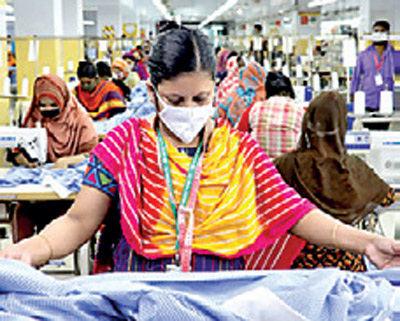Thursday Dec 04, 2025
Thursday Dec 04, 2025
Monday, 2 August 2021 00:23 - - {{hitsCtrl.values.hits}}
 Vietnam overtook Bangladesh in the global apparel market and became the second-largest global ready-made garment (RMG) exporter.
Vietnam overtook Bangladesh in the global apparel market and became the second-largest global ready-made garment (RMG) exporter.
Bangladesh now stands in the third position, with China holding its first position. According to the World Trade Statistical Review 2021 released by World Trade Organization (WTO) on Friday, Bangladesh’s share in the global apparel market dropped to 6.3% in 2020 from 6.8% a year earlier.
The market value for Bangladesh was $ 28 billion in the year 2020. Meanwhile, the share of Vietnam in global RMG exports stood at 6.4% in 2020, up from 6.2% a year earlier.
Vietnam’s market value stood at $ 29 billion at the end of 2020.
To put it into perspective, the share of Vietnam in the global export market was 2.9% back in the year 2010 while Bangladesh’s share in the global apparel export market was 4.2%, which was 85.5% more than Vietnam’s.
Apparel manufacturers and economists said that Bangladesh has lost its position to Vietnam amid the latest trend of decline in apparel export, which was further tapered by the pandemic.
Moreover, Bangladesh’s RMG export has been declining significantly due to the closure of a number of small RMG factories over the last few years as they failed to maintain strict compliance set by the international retailers and brands and also for the offering of lower prices by the international buyers.
In addition, Vietnam has diversified goods at a competitive price, which Bangladesh cannot afford. “Vietnam has attained Bangladesh’s position as the world’s second-largest apparel supplier by concentrating on product diversification,” they also said.
Economists said that Vietnam and the European Union (EU) signed the Free Trade Agreement (FTA) in June 2019, which allowed Vietnam to enjoy the zero-duty benefit to this largest trading bloc of the world.
Since Vietnam has an FTA with the EU, Bangladesh has been facing a challenge from Vietnam as both countries have been producing the same kinds of products, they added.
Moreover, Vietnam has a lot of Chinese investment, which is a big plus point for this country and has been playing a vital role in the progress in exports of the country.
Globally, Bangladesh is a popular destination for low-end manufacturing items at the cheapest rate while Vietnam produces high-end apparel with a strong backward linkage industry and educated workforce.
Although Bangladesh and Vietnam had been holding the second and third positions respectively in the apparel export, the business dynamics and environment are quite different in the two competing countries, said the exporters and economists.
Experts opined that Bangladesh should diversify its export basket including within the RMG sector.
Prof. Mustafizur Rahman, a distinguished Fellow of the CPD, said that the situation can only be defined as a transaction period as Bangladesh and Vietnam have been competing closely for decades.
“Last year, the pandemic’s condition was relatively good in Vietnam, while Bangladesh’s garments were closed for a significant time due to the pandemic,” he added.
He also said that now Bangladesh is getting a lot of purchase orders and the orders are shifting to Bangladesh from China, India and even Vietnam. “So, I think Bangladesh will be able to regain its position soon,” he said.
However, COVID-19 cannot be blamed for everything as Bangladesh has many weaknesses, he also said.
“Vietnam is far ahead in labour productivity, capital productivity and diversification. We need to improve these. We need to increase skills, move from low end to high end, increase value addition, product basket diversification, and reduce lead time,” he added.
BGMEA Vice-President Shahidullah Azim said that Vietnam’s export growth remained unhurt during March-May of the last while Bangladesh’s exports steeply nosedived during the time.
“We need to focus on products that add value. Our number of exporters is more than Vietnam, but they are ahead of us in value addition,” he added.
He also said that, although synthetic fibre is the future of the export-oriented garment sector, Bangladesh lagged behind in producing synthetic fibre-made garments.
“We demanded a 10% cash incentive for man-made fibre-based products in the current fiscal year. But it ultimately went unaddressed. Government should approve it and the import of man-made fibre also needs to be duty-free,” he added.
Moreover, the manufacturers also said that they need loan facilities as well as easy access to cash assistance to maintain their position in the global RMG market.
(Source: https://www.dhakatribune.com/business/2021/07/31/vietnam-overtakes-bangladesh-becomes-2nd-largest-rmg-exporter)